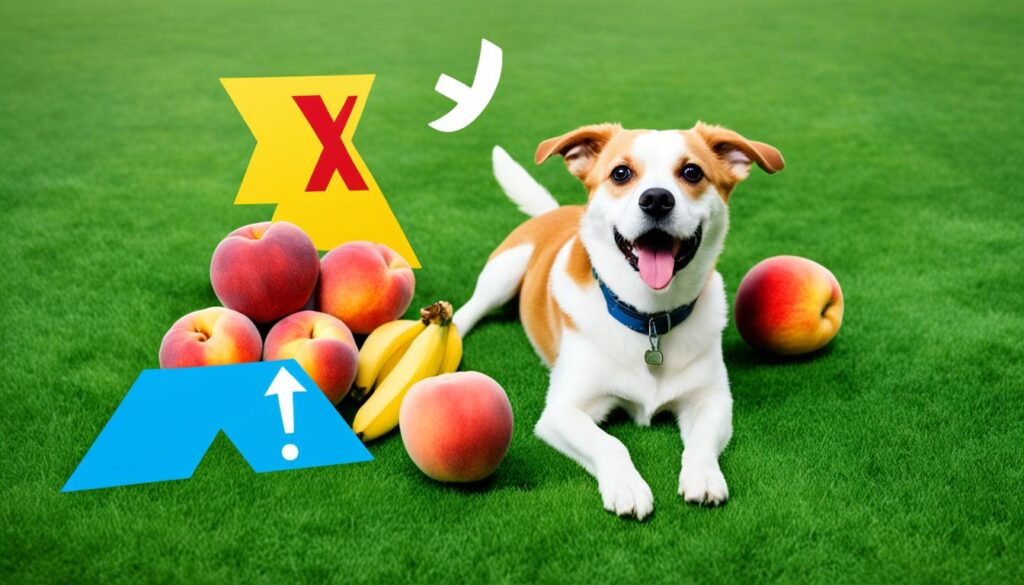As an Amazon Associate I earn from qualifying purchases.
Picture this: it’s a warm, sunny day, and you’re enjoying a juicy, ripe peach that drips with sweetness. The flavor is divine, and you can’t help but savor every bite. Suddenly, your furry friend gives you those puppy dog eyes, begging for a taste. You pause, wondering if dogs can have peaches too. Well, wonder no more! We’re here to give you the lowdown on whether those peachy delights are safe for your four-legged companion.
Key Takeaways:
- Dogs can safely eat the flesh of a peach, but caution is needed with other parts of the fruit.
- Peach pits, leaves, and stems are toxic to dogs and should be avoided.
- Some dogs may have an allergic reaction to the fuzzy skin of peaches.
- When feeding peaches to your dog, always remove the pit and cut the flesh into small pieces.
- Monitor your dog for any adverse reactions and offer peaches in moderation as a treat, not a replacement for a balanced diet.
Are Peaches Healthy for Dogs?
Peaches can be a healthy addition to your dog’s diet when given in moderation. Not only are they delicious, but they also offer a range of nutrients that can contribute to your furry friend’s overall well-being.
Feeding peaches to dogs provides them with a good source of vitamins A and C, which are essential for a strong immune system and healthy skin. These vitamins also act as antioxidants, helping to protect your dog’s cells from damage caused by free radicals.
In addition to vitamins A and C, peaches contain other beneficial nutrients such as vitamin E, niacin, and potassium. Vitamin E is involved in maintaining healthy skin and coat, while niacin supports proper digestion. Potassium, on the other hand, plays a crucial role in maintaining proper heart and muscle function.
However, it’s important to remember that peaches should not replace a balanced diet for your dog and should only be given as an occasional treat. While peaches offer nutritional benefits, they should be complemented by a well-rounded canine diet that includes high-quality dog food.
“Feeding your dog peaches can be a tasty and nutritious way to spoil them, but always remember to offer peaches in moderation and as part of a balanced diet.”
Can Dogs Have Peaches Safely?
Are peaches safe for dogs? Generally, the flesh of the peach is safe for dogs to eat. However, there are a few important considerations to keep in mind to ensure your dog’s safety.
Firstly, you should never feed your dog the pit, leaves, or stem of a peach. Peach pits contain a naturally occurring form of cyanide, which can be toxic to dogs if ingested. It’s essential to remove the pit and any other non-edible parts before offering your dog a peach.
Furthermore, while the skin of the peach is generally safe, some dogs may have a mild oral allergic reaction to the fuzzy texture. If you notice any signs of an allergic reaction after your dog has eaten peach skin, such as excessive salivation or rubbing at the face, it’s best to avoid giving them peaches in the future.
The Dangers of Peach Pits
When it comes to peaches, the pit is the real villain for dogs. These seemingly innocent seeds actually contain a naturally occurring form of cyanide, which can be highly toxic for our furry friends. If your dog chews on a peach pit, it can release more of the toxin, leading to cyanide poisoning. As a responsible pet owner, it’s important to be aware of the risks associated with giving dogs peaches.
Aside from poisoning, peach pits can also pose a choking hazard for dogs. Their small size and hard texture make them a potential danger if swallowed. Ingesting a pit can cause intestinal blockage, which requires immediate medical attention. So, keep an eye on your four-legged buddy and make sure they don’t get their paws on those pits!
If you suspect that your dog has ingested a peach pit or is showing signs of gastrointestinal obstruction, such as vomiting, diarrhea, or abdominal discomfort, it’s crucial to contact your veterinarian right away. Acting quickly can help prevent serious complications and ensure the well-being of your beloved pet.
Remember: While the idea of sharing your favorite summer fruit with your furry companion may seem tempting, the risks associated with peach pits are just too great. It’s important to prioritize your dog’s safety and well-being. So, when it comes to peaches, leave the pits behind and focus on the delicious, juicy flesh that your dog can safely enjoy.
The Fuzz and Other Considerations
While the flesh of the peach is generally safe for dogs, some dogs may have a mild oral allergic reaction to the fuzzy skin. Symptoms of an allergic reaction may include excessive salivation, rubbing at the face, smacking motions with the mouth, or refusal to eat. If your dog shows any of these signs after eating peach skin, it’s best to avoid giving them peaches in the future. Additionally, it’s important to wash peaches thoroughly to remove any pesticides or dirt before offering them to your dog.

- Some dogs may have an oral allergic reaction to peach skin.
- Watch out for symptoms like excessive salivation and refusal to eat.
- Wash the peaches well to remove any pesticides or dirt.
“A dog’s allergic reaction to peach skin should be taken seriously. Always prioritize your furry friend’s well-being and consult with your veterinarian if you suspect an allergy.”
Safely Feeding Peaches to Your Dog
To keep your furry friend safe while enjoying this sweet summer treat, here are some important tips on how to safely give your dog peaches:
- Remove the Pit: The pit of a peach can be hazardous to dogs, as it contains cyanide. Be sure to remove the pit and any other non-edible parts, such as the stem and leaves.
- Cut into Bite-Sized Pieces: To prevent choking and aid in digestion, always cut the peach flesh into small, bite-sized pieces for your dog.
- Peel the Skin: Some dogs may have an allergic reaction to the fuzzy skin of peaches. To minimize the risk of an allergic reaction, it’s recommended to remove the skin before feeding peaches to your dog.
- Moderation is Key: While peaches can be a nutritious addition to your dog’s diet, it’s important to feed them in moderation. Peaches should be offered as an occasional treat and not as a substitute for a balanced diet.
- Opt for Fresh Peaches: Fresh peaches are preferred over canned or preserved ones, as they may contain higher levels of sugar or harmful additives. Stick to natural, fresh peaches for your dog.
By following these guidelines, you can safely give your dog peaches and ensure they enjoy this summertime fruit without any risks or complications.
Remember, always prioritize your dog’s health and well-being. If you have any concerns or notice any unusual symptoms after feeding your dog peaches, consult with your veterinarian.
| Benefits | Risks |
|---|---|
|
|

The Benefits and Risks of Peaches for Dogs
Peaches offer a range of benefits for dogs, from providing essential nutrients to supporting overall well-being. However, it’s important to be aware of the potential risks associated with peaches, particularly the dangers of peach pits.
When it comes to the benefits, peaches are packed with vitamins A and C, which play a crucial role in maintaining a healthy immune system and promoting optimal health. Additionally, peaches contain fiber, which aids in digestion and supports gastrointestinal health. The antioxidants found in peaches can also help reduce oxidative stress and protect against cellular damage.
“Peaches provide dogs with a tasty and nutritious snack that can help support their immune system and digestive health.”
However, the pit of a peach poses significant risks to dogs. Peach pits contain cyanide, a substance that is toxic to dogs. If a dog ingests the pit, it can lead to cyanide poisoning, which can be life-threatening. In addition to the toxic properties, peach pits can also cause choking or intestinal blockage if swallowed.
It’s important to exercise caution when feeding peaches to your dog and take steps to minimize the risks. Always remove the pit and any non-edible parts of the peach before offering it to your dog. Cutting the flesh into small, bite-sized pieces can help prevent choking, and removing the fuzzy skin may reduce the risk of allergic reactions.
Remember to introduce peaches to your dog’s diet in moderation and as part of a balanced meal plan. Fresh peaches are preferable to canned or preserved ones, as they may contain higher levels of sugar or harmful additives.
By being mindful of the benefits and risks of peaches for dogs, you can safely incorporate this summertime fruit into your dog’s diet and provide them with a flavorful and nutritious treat.
Quick Tips for Feeding Peaches to Your Dog:
- Remove the pit and any non-edible parts of the peach.
- Cut the flesh into small, bite-sized pieces to prevent choking.
- Consider removing the fuzzy skin to minimize the risk of allergic reactions.
- Feed peaches in moderation as part of a balanced meal plan.
- Choose fresh peaches over canned or preserved options.
Conclusion
So, can dogs eat peaches? The answer is both yes and no. While the juicy flesh of a peach can be a tasty and nutritious treat for your furry friend, it’s crucial to be aware of the potential dangers that come with it.
First and foremost, remember to steer clear of the pit, leaves, and stem of the peach. These parts contain cyanide, a toxic substance that can have severe consequences if ingested by your dog. Always remove them before offering any peach to your pet.
Additionally, some dogs may have a sensitivity or allergic reaction to the fuzzy skin of peaches. Keep an eye out for symptoms such as excessive salivation, rubbing at the face, or refusal to eat. If your dog displays any of these signs, it’s best to avoid giving them peaches in the future.
To safely feed peaches to your dog, cut the flesh into small, bite-sized pieces to prevent choking, and remove the fuzzy skin if needed. Remember that moderation is key. Offer peaches as an occasional treat and not as a substitute for a well-balanced diet.
FAQ
Can dogs safely eat peaches?
Are peaches healthy for dogs?
What are the dangers of peach pits for dogs?
Can dogs be allergic to peaches?
How can I safely feed peaches to my dog?
What are the benefits and risks of peaches for dogs?
Source Links
- https://www.thedodo.com/dodowell/can-dogs-eat-peaches
- https://www.purepetfood.com/help/can-dogs-eat-peaches
- https://www.houndgames.com/can-dog-eat-peaches/
As an Amazon Associate I earn from qualifying purchases.

